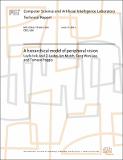| dc.contributor.advisor | Tomaso Poggio | |
| dc.contributor.author | Isik, Leyla | en_US |
| dc.contributor.author | Leibo, Joel Z. | en_US |
| dc.contributor.author | Mutch, Jim | en_US |
| dc.contributor.author | Lee, Sang Wan | en_US |
| dc.contributor.author | Poggio, Tomaso | en_US |
| dc.contributor.other | Center for Biological and Computational Learning (CBCL) | en_US |
| dc.date.accessioned | 2011-06-20T19:45:08Z | |
| dc.date.available | 2011-06-20T19:45:08Z | |
| dc.date.issued | 2011-06-17 | |
| dc.identifier.uri | http://hdl.handle.net/1721.1/64621 | |
| dc.description.abstract | We present a peripheral vision model inspired by the cortical architecture discovered by Hubel and Wiesel. As with existing cortical models, this model contains alternating layers of simple cells, which employ tuning functions to increase specificity, and complex cells, which pool over simple cells to increase invariance. To extend the traditional cortical model, we introduce the option of eccentricity-dependent pooling and tuning parameters within a given model layer. This peripheral vision system can be used to model physiological data where receptive field sizes change as a function of eccentricity. This gives the user flexibility to test different theories about filtering and pooling ranges in the periphery. In a specific instantiation of the model, pooling and tuning parameters can increase linearly with eccentricity to model physiological data found in different layers of the visual cortex. Additionally, it can be used to introduce pre-cortical model layers such as retina and LGN. We have tested the model s response with different parameters on several natural images to demonstrate its effectiveness as a research tool. The peripheral vision model presents a useful tool to test theories about crowding, attention, visual search, and other phenomena of peripheral vision. | en_US |
| dc.description.sponsorship | This work was supported by the following grants: NSF-0640097, NSF-0827427, NSF-0645960, DARPA-DSO, AFSOR FA8650-50-C-7262, AFSOR FA9550-09-1-0606. | en_US |
| dc.format.extent | 13 p. | en_US |
| dc.relation.ispartofseries | MIT-CSAIL-TR-2011-031 | |
| dc.relation.ispartofseries | CBCL-300 | |
| dc.rights | Creative Commons Attribution-NonCommercial-NoDerivs 3.0 Unported | en |
| dc.rights.uri | http://creativecommons.org/licenses/by-nc-nd/3.0/ | |
| dc.subject | peripheral vision, computational neuroscience, HMAX | en_US |
| dc.title | A hierarchical model of peripheral vision | en_US |
| dc.language.rfc3066 | en-US | |
